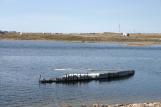1
Cambridge Bay is also known as "Iqaluktuuttiaq" which means "place of many big fish". For hundreds of years, Inuit have traveled from all over to reach this spot for the good fishing, and very few go home empty handed. Cambridge Bay is also a good hunting spot with seasonal animals such as caribou, musk oxen, and many different types of birds.3
Cambridge Bay town did not exist until foreigners from the south arrived. Even when the Hudson's Bay Company was established in 1921, the settlement was not permanent. This changed in 1947, when the United States armed forces established the Loran Beacon (long range navigation). Construction of the beacon employed 20 or more Inuit, many of whom started settling in town with their families. At first, only 3 or 4 families started establishing their lives in the "Old Town," building houses with scrap lumber around the RCMP post and the Anglican St. George's Mission. Today, the tower still operates as a weather station and radio communication facility.The contruction of the Distant Early Warning System (DEW line) in 1955 led to a great expansion of Cambridge Bay's population. About 200 Inuit were employed during its construction. Since the DEW line was establisbed further west of the Old Town, the town started shifting to its current location, which is across the bay from the Old Town.
Photo by A. Chapeskie
5
This photo shows the "New Town" of Cambridge Bay in the 1960s. The town was originally located across the Bay, but was moved to its current location during the 1950s due to the construction of the Dew Line Station. There is still evidence of the "Old Town" visible from across the bay.7
The Old Stone Church is one of the historic sites in Cambridge Bay. The construction of the stone church in the Old Town began in 1953, organized by Fathers Lemur, Steinman, and Menez. It was the first Cambridge Bay church, and was inaugurated on September 10th,1954. By that time, Cambridge Bay's population had increased to about 300 Inuit.To protect the historic structure, the community has attempted two recent reconstruction efforts. The first, in the mid 1980s, included new asphalt shingles, the reconstruction of the bell tower, grouting of loosened stonework, and new windows. The second reconstruction occured in 1988. During this reconstruction project, approximately 70% of the structure's stone walls were rebuilt, using a high strength grout.
Photo by A. Chapeskie
9
The "Maud", now called the "Baymaud," was built in Norway in 1917 for Roald Amundsen. The ship was named after the Queen of Norway, and was especially built to withstand the extremely cold weather and difficult sea ice conditions in Arctic waters. Amundsen's initial plan was to travel to the northpole, but after he was nearly killed twice, the ship did not reach the northpole. Instead, the ship sailed to Seattle, Washington in 1925, where the Maud was sold to the Hudson Bay Company. The ship was renamed "Baymaud" in 1926 and was used to supply HBC outposts in the western Arctic. The ship was moved to Cambridge Bay the following year where the Hudson's Bay Company reopened a trading post.After being damaged in the winter of 1926-1927, the ship was moored in Cambridge Bay where it was used as a floating warehouse, machine shop, and wireless station.
The ship eventually developed a leak and sank in 1930. Remnants of the Baymaud can still be seen on the surface of water.
11
The Eagle, a longliner originally owned by Johnny Norberg of Tuktoyaktuk, was purchased by Father Steinman in 1954. Father Steinman was one of the missionaries involved in the construction of the stone church. The Eagle was towed from Tuktoyaktuk to Cambridge Bay but leaked during the entire journey. Since Steinman was the only priest who knew anything about boats, he planned to repair the boat. However, he was stationed elsewhere in 1954.The Eagle has remained by the shore just south of the stone church ever since.






